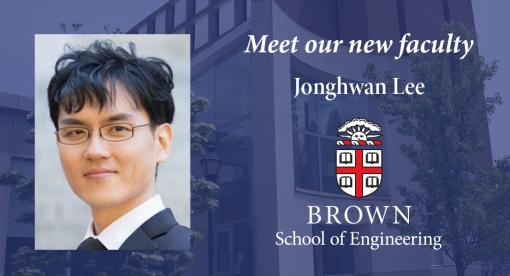 Jonghwan Lee once thought that controlling a computer just by thinking about it was the stuff of science fiction. Then he read about brain science research at Brown. Now he's here.
Jonghwan Lee once thought that controlling a computer just by thinking about it was the stuff of science fiction. Then he read about brain science research at Brown. Now he's here.
Jonghwan Lee was all set to go to graduate school to study low-temperature physics when he saw something that changed his path.
In the early 2000s, Lee saw a news story about Brown neuroscientist John Donoghue's work on brain-computer interfaces. Donoghue had just shown that monkeys fitted with neural implants could control a cursor on a computer screen with their thoughts. Brown and several partner institutions are now testing that technology, called BrainGate, in a clinical trial where people operate computers and robotic arms just by thinking about moving an arm and hand.
"When I was a kid, I had a kind of naive dream about making a robot that I could control by thinking," Lee said. "But at the time I thought that kind of dream was just scientific fiction."
Now he saw that such technologies were real and could be of great benefit to people with disabilities.
"It changed my life," he said.
So instead of low temperature physics, Lee went on to get a Ph.D. in neural engineering from the Seoul National University in South Korea. Now, after a postdoctoral program in biomedical imaging at Harvard Medical School, he comes to Brown's School of Engineering as an assistant professor. He's happy to end up at the place that inspired his research path.
Among the projects Lee has been working on in his lab at Harvard is a system that uses optical imaging to read signals from the brain. The Micro-Optical Neuronal Activity Scanner (MONAS) looks at the way infrared light reflects off of neurons. It can be used for research aimed at understanding how the brain responds to stimuli or coordinates body movements — with single-neuron resolution.
The system has the potential to be much less invasive than most of the brain recording methods used today. Current systems require electrodes inserted directly into the brain or fluorescent dyes. Electrodes are highly invasive, and dyes could have toxic side effects. In mice, Lee has shown that the system can work without even opening the skull. Lee says he'd ultimately like to test the device in humans. For that, the device would likely need to be implanted beneath the skull (human skulls are a bit thicker than those of mice), but it would still be far less invasive than an electrode implanted deep in the brain.
Lee hopes that one day the device might be used to translate brain signals to operate robotic prostheses in much the same way BrainGate does.
MONAS makes what amounts to a three-dimensional, microscopic movie of activity in the brain. Lee uses that same type of output for another imaging system he's developing.
The system combines his theory on light waves reflected from moving particles with an imaging technique known as optical coherence tomography. The system enables imaging down to the scale of organelles as they move within cells. The system can also measure blood flow in tiny capillaries. Lee hopes the new technology will be useful for a number of applications. One he has in mind is investigating mechanisms underlying stroke in animal models.
"Using our technology, we can measure the blood flow quantitatively," he said. "At the same time, we can see how individual cell viability changes over time by imaging the movement of organelles."
Lee will continue developing these technologies in his new lab at Brown, which is funded in part by a grant from the National Institutes of Health. He plans to run his lab in a way that prepares students for careers both in academia and industry. The skill sets required for each, Lee says, tend to be a bit different.
"For students who want to go into academia, their training will be focused more on writing papers, writing grants, and literature searches," Lee said. "But if a student wants to pursue the industry track, then their training will be more focused on project management and intellectual property-related skills, while trainings in biomedical optics and neural engineering are common in both tracks."
"I want to make education and research programs in my lab to make my students successful in their careers."
- by Kevin Stacey